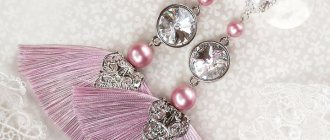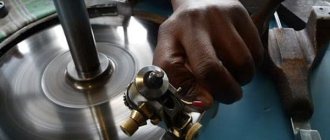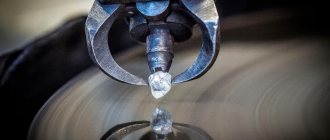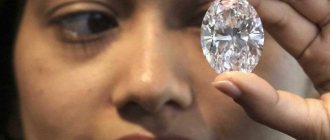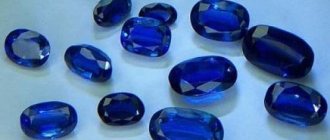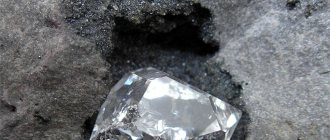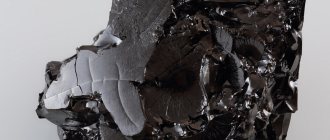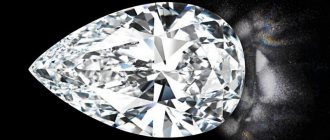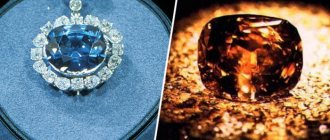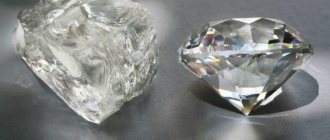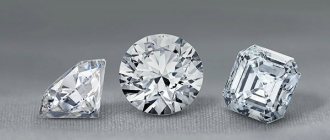Perhaps everyone knows that diamond is the hardest mineral on earth. Thanks to this characteristic, the gem is often used not only in the jewelry industry, but also in other areas where hardness is of high importance. Everyone is familiar with such concepts as “diamond sputtering”, “diamond chips” or “diamond drilling”. But why does the stone have such a high level of hardness, since it, like graphite, consists entirely of carbon? And graphite, as you know, has a completely opposite hardness rating, which is 1-2 on the Mohs scale.
Diamond Durability
Gemstones are valued for their beauty, rarity and durability. Durability is the ability of a gemstone to withstand wear, heat, and chemicals. The concept of durability consists of three properties:
- Hardness: How well a gemstone resists scratching and abrasion
- Durability: How well a gemstone resists breaking and chipping
- Stability: How well a gemstone resists chemicals and thermal shock
Diamond is a very stable and extremely hard stone, but not as strong. Its hardness is uneven in different directions of the crystal and this is important both for the cutting process and in terms of the durability of diamonds of various shapes and cuts.
Is it possible to break a diamond with a hammer?
The incomparable Marilyn Monroe sang the praises of this gemstone in the 1953 film “Gentlemen Prefer Blondes,” and to this day diamonds remain a girl’s best friend and one of the most desirable among other stones.
Along with real diamonds, the market is filled with fakes and stones that are very similar to diamonds. Natural substitutes - quartz (rock crystal), white zircon, moissanites, artificial - cubic zirconia, lab-grown artificial diamonds, synthetic moissanites, all of them decorate many products, including jewelry. By themselves, they also look beautiful, but these are not natural diamonds formed in the earth’s crust under the influence of high pressure and temperature.
How to determine the authenticity of a diamond?
Without a doubt, this can only be done by a certified gemologist, a jewelry specialist. The Euroskupka company provides qualified services in the evaluation and purchase of diamonds. To check a stone, various devices are used: detectors, testers, refractometers, magnifying glasses, sets of diamond size standards, etc., which allow one to distinguish a real diamond from imitations by measuring thermal conductivity, electrical conductivity, weight, and reflectivity. You can try to determine the authenticity of a diamond yourself using the following tips (not guaranteeing a 100% answer):
Hardness
Diamond's hardness is a result of its very compact crystal structure. The scratch hardness of diamond is five times higher than that of carbides. The picture on the left illustrates the hardness of diamond compared to other materials according to the Mohs and Knoop scales. However, diamond is relatively brittle and cracks may occur if impacted during processing” (VC Venkatesh and S. Izman, Precision Engineering, 2007, p. 50). Diamond is the hardest known mineral on both the Mohs and Knoop scales, which measure a mineral's scratch resistance due to the ability of a harder material to scratch a softer material.
crushing diamond with hammer
Jan 23, 2019 · Diamond is an incredibly hard stone, but at the same time very fragile. Therefore, do not rush to hit your mother’s diamond earring with a hammer out of scientific interest!
Tips for working with a jackhammer - article by Diam Almaz
Tips for working with a jackhammer A jackhammer is a popular tool that is used in repair and construction work, to
crusher with metal hammer
crusher with metal hammer. care and maintenance of mobile chrome ore crushers.glasses iron ore crusher 100 tons per hour.crushing cost per ton of coal.500 tons mobile iron ore crushing
Operating principle and purpose of hammer crushers
As a result of a blow with a hammer, the piece is destroyed, its fragments scatter and are thrown onto the lining by impact plates or grates, forming a crushing chamber.
lime hammer crusher factory address
lime hammer crusher factory address. The crushing cavity is 1.5 or even 2 times larger than other crushers, large feeding mouth Hammer crusher with
Strength
Diamonds can chip or shatter from a strong impact, especially in areas where the carbon atoms have not formed strong bonds. These areas, called cleavage planes, are the main source of damage to diamonds (see Figure 2). The toughness scale used in the scientific literature is called the fracture toughness scale, but it is rarely mentioned in gemology. The toughness scale measures (in erg/cm2) the work required to separate two crystal surfaces along some crystallographic plane. Values on this scale for diamond typically range from 5,000 (along the cleavage planes) to over 8,000 (in the “hardest” direction). Compare these values to 225,000 for jade and 120,000 for jadeite, which are stronger, and 600 for corundum, which is not as strong.
Figure 1. Carbon atoms are arranged in very narrow rows. In the directions where the carbon atoms are most compact, it is very difficult to break a diamond. Note that the atoms also lie in planes. The distances between planes are larger than other distances between carbon atoms. In directions where the atoms lie in planes, diamonds can break, although with difficulty. These directions are called cleavage planes.
What is the Mohs Hardness Scale for Metals and Minerals
The Mohs scale is a measurement table that allows you to find out the hardness of a mineral and stone material. Such a scale appeared in the 19th century, and the name is identical to the name of the creator. After developing and conducting a number of studies, the measurement indicator became very popular due to its maximum accuracy and efficiency in the context of splitting production activities.
Determining the index of metals and minerals on the Mohs scale allows you to select the correct material processing technology to create comfortable operating conditions. And thanks to accurate indicators, accurate information is provided in terms of whether a diamond can be melted or whether it is better to break it with a hammer, and whether this is even possible. The technical properties of each stone material are ideally described on the scale of a renowned geologist.
Diamond's Achilles heel
Although diamond is the hardest natural material, it can chip and shatter during normal wear. Diamond forms a cubic crystal structure and has four weak cleavage directions. The cleavage plane is the weakest direction in the molecular structure of a crystal. Diamonds are stiffer in directions where the atoms are tightly bonded to each other and less rigid in directions where they are not as tightly bonded. The most common crystal shape for natural diamond is the octahedron and the focus will be on this typical shape. Cleavage is the splitting of a diamond crystal parallel to one of its triangular octahedral planes. A natural diamond crystal can only be split parallel to one of the triangular octahedral faces (Fig. 2).
Because diamonds are harder and tougher along certain directions of the octahedral crystal, they are also more resistant to being crushed, abraded, or cut by other diamonds along those directions (Figure 3). There are also softer directions. For some of the famous historical diamonds, months were spent planning before cleaving because the external intended shape was limited to the octahedral directions.
Today, diamonds are rarely split. Usually they are sawn, and, more recently, cut with a laser. However, cutters still need to understand hard and light polishing directions, as well as the location of cleavage planes to plan cuts. The octahedron usually produces a round diamond only from a specific location in the crystal (Figure 4).
During the planning stage of sawing, the top portion is first cut off so that it can be used to produce another diamond. Note that the typical crown (top) of a round diamond is slightly taller than the typical princess cut crown. If a cutter wants to create two princess-cut diamonds from one crystal, the planning is a little different than when cutting two round diamonds (Figure 5).
Remember that diamonds are harder in directions where the atoms are tightly bonded to each other and less hard in directions where they are not so tightly bonded. Look at the placement of the corners in the princess cut, which are very vulnerable to chipping because they lie close to the cleavage plane. Cuts like these, with pointed corners or ends, are often set into the piece with a scalloped caste to protect the corners from chipping. However, a strong blow to a prong on the corner of a diamond (Figure 6) can cause a crack to appear. It's not quite in the cleavage plane, where the carbon atoms are far apart, but very close to it. When chips appear, they rarely look smooth and flat. Rather, they will appear stepped because they are not located directly on the cleavage plane.
Most of the time it's just a cleanliness issue.
People often mistake a diamond for being cracked when they see a whitish line running through the diamond. Instead, the culprit is a dirty diamond that has a concentrated layer of built-up dirt on it.
You see, throughout the day, the diamond ring you wear on your hand inevitably comes into contact with external substances (such as hand soap, water, your fingers, etc.) and slowly accumulates dirt.
Initially, this layer of dirt may appear as a thin layer of dirt or a slick of oil slick. Over time, the dirt accumulates and becomes so thick that it looks like a thick white line on the edges of a diamond. Depending on where the debris has accumulated, it can be mistaken for a crack or a sign of physical damage to the stone.
“Crack Repair” – Diamond Cleaning
As the diamond's surface becomes dirtier, the stone becomes dull and lifeless. In turn, some inclusions that were previously masked by the shine and shimmer of the stone will now become more obvious. This can trick your eyes into believing that new imperfections have appeared when they have been there all along.
By cleaning the diamond and removing large amounts of dirt, you can easily restore the stone to its original condition. All you need is a soft brush and a small amount of detergent to get the job done.
If your ring setting has corners that are difficult to reach with a bristle brush, you may want to consider using an ultrasonic cleaner or taking it back to your jeweler for a professional steam cleaning.
How can a jeweler reduce the size of a ring?
Cutting out a piece of tire
Most often used for processing rings with stones decorated with colored enamel. To reduce the ring by one size, a piece 3.14 mm long is removed from the rim, and by two - 6.28 mm. Afterwards, the joint is ground and polished well.
Laser soldering is used for particularly delicate items, as well as for all white metal jewelry.
Compression
The method is used for simple rings without inlay, mostly for reducing and adjusting wedding bands. If the ring needs to be reduced by half a size, it is knocked down, and if it needs to be reduced by 1-2 sizes, it is first heated and then knocked down to the desired parameters. The soot that appears on the surface is cleaned off, and the ring is polished to a new condition.
Density (specific gravity) of diamond
The specific gravity of diamond, namely the density coefficient, is in the range of 3.417-3.55 g/cm³, which indicates the ability of an already processed product to cope with mechanical loads during processing in order to obtain the desired shape and size.
Interesting! Given the same volumes, diamond will be approximately 3.5 times heavier than water.
Is it possible to break a diamond with a hammer?
Diamond is used in jewelry, industry and construction as a coating for special equipment, and therefore many are interested in the question: is it possible to break a diamond with a hammer to obtain the appropriate technical and decorative properties?
If we talk about working with real diamond, and not a synthetic analogue, then it provides high strength, the indicator of which is at the top of the Mohs scale in terms of hardness, then it is impossible to break it with a hammer. The fact is that diamond is several tens of times stronger than steel. But if we are talking about a synthetic version of diamond, then it is easily susceptible to mechanical destruction using a jackhammer or sledgehammer.
But how do jewelers process a diamond to obtain the desired shape and precise edges? The fact is that here we are talking about the use of special technologies for processing the material, namely, a press is used if you need to create crumbs from the material or a technique of heating and beating. It all depends on what kind of gemstone you want to achieve.
What is recutting and how can it help?
Recutting is simply the process by which a jeweler creates a smaller stone from a larger one. The name itself suggests that the diamond is cut again, part of it is removed and the stone is reduced in carat weight.
A lower carat weight means your diamond also becomes less valuable. How much your stone will lose in value will depend on how severe the damage is.
The larger the chip, the more diamond the jeweler will have to remove. Plus, recutting will cost you extra money.
If you don't want to pay more and the chip doesn't bother you too much, you can always leave it as is.
What can it be easily confused with?
The colorless transparency of most diamonds makes them visually indistinguishable from glass and other stones:
- rock crystal;
- colorless topaz;
- white zirconium;
- leucosapphire;
- quartz.
Synthetic materials such as moissanite, cubic zirconia, and rutic do not create problems - they are distinguished from diamond gems by their cut and brilliance.
Artificial diamond has other qualities (for example, low transparency). Used in technology and industry.
Defects (flaws) in diamonds: which ones to watch out for and which ones not to
As the famous American jeweler Harry Winston said, the most important thing in a diamond, as in a person, is its individuality. Diamond has been associated with perfection for centuries, but it itself is far from perfect. Each stone has its own history and its own shortcomings.
Finding one perfect diamond in nature is incredible luck and a pleasant exception. Almost all diamonds, even of the highest quality, suffer from minor defects. But this is precisely what confirms their uniqueness and authenticity.
What are defects (flaws) in diamonds? How can you recognize them correctly? Which defects should you be wary of and which should you not? Read about all this in a new article from YK!
Split
The first stage of diamond processing is its splitting. Of course, it would be interesting to get the stone as large as possible and not split it at all, but this can entail high brittleness if there are multiple inclusions or cracks. Previously, splitting was done using a chisel and a hammer after careful calculations by the master. But this often led to errors, and the stone could be damaged.
Recently, sawing has begun to be used instead of splitting. For these purposes, a diamond saw blade is used, consisting of chalk and covered with precious stone chips. This blade rotates at a speed of 10 thousand revolutions per minute and gradually cuts the diamond.
The process can take a very long time; one stone weighing 1 carat can take up to 8 hours to cut. But recently an even more reliable method has appeared - now a laser is used for these purposes.
Friction - This procedure produces the rough shape of the diamond. Two diamonds are fixed on a lathe or special installation, after which they are installed in the correct direction and rub against each other.
Basic characteristics of a diamond
The price of a gemstone is determined by its quality. It consists of four main criteria:
- Carat.
- Features of the cut.
- Color.
- Purity of the stone.
Let's take a closer look at each of them.
Carat
To make it easier to measure precious stones and pearls, a non-systemic unit of mass was introduced - the carat. It is equal to 200 milligrams.
The heavier the stone, the more expensive it is.
The largest diamond found weighed an incredible 3,106 carats. The price of one carat of a good quality diamond is approximately 750,000 rubles. Remember what we said about the price of a gram of cubic zirconia...
